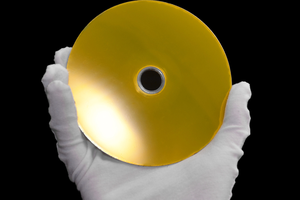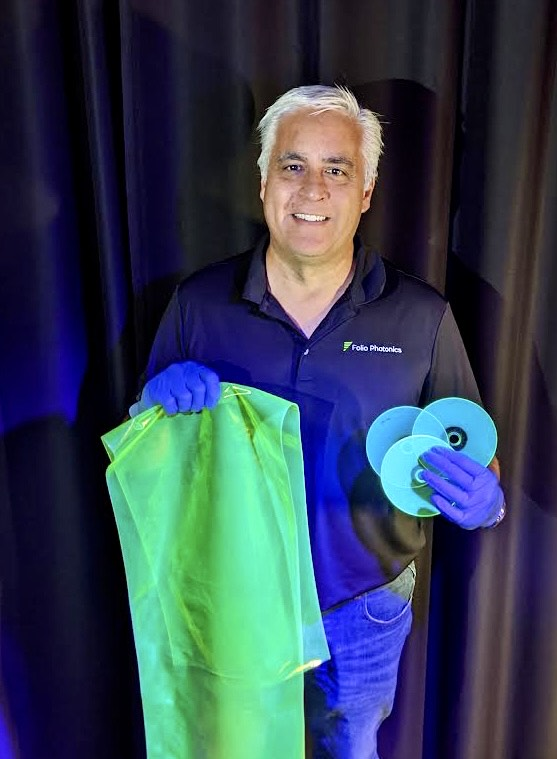Folio Photonics Wants To Kill HDDs With Film

Folio Photonics has a fancy new storage media that it believes can kill off active archives that currently live on hard disks.
Based in Solon, Ohio, the company is a spin-out from Case Western Reserve University based on the work of company founder and CIO Dr Kenneth Singer. Singer was experimenting with embedding photosensitive material in layered polymers, and at a meeting with a storage industry executive it was pointed out that this could be made into an optical storage disc, like Blu-ray discs.
If they could get it to work.
Blu-ray discs are made by adding thin layers of data material onto a disc one at a time, but only a few layers are possible. The Blu-ray discs you're used to only have two layers, storing up to 50GB per disc. More specialised three- and four-layer discs (storing 100GB and 128GB respectively) are available but are far less common. Adding more layers would mean more data per disc.
After a few years of work, and navigating a global pandemic, CEO Steven Santamaria says they've cracked it.

“Starting earlier this year we started writing to a five- and six-layer disc, and we're now announcing that we're writing to an eight-layer disc,” Santamaria says. “This is what people said we couldn't do, because a lot of people have failed in front of us.”
The first Folio product will store about 1 terabyte, per disc, and Santamaria would like Folio to be able to double that every two years. “We'll alternate between increasing density of the film, and adding layers,” he says.
A new kind of active archive
A new, high-density Write-Once-Read-Many (WORM) disc is all well and good, but the market already has plenty of storage options. From RAM and storage-class memory at the fast, small, and expensive end, though flash and HDDs and on to the big, cheap, and apparently unkillable tape. Can Folio find a profitable place to call home?
Santamaria certainly believes so and the key, he says, is a combination of access speeds and price.
“The faster archive tier is where we're more interested. That's primarily covered by HDDs today,” says Santamaria. Flash is expensive for large datasets, but HDDs consume power that is getting more expensive, and need to be constantly replaced as they wear out and die. For data that doesn't change, the cost of keeping it alive on HDDs adds up.
For fast recovery from immutable media, such as restoring data after a ransomware attack, access times of under a minute are fine. It's hard to get more immutable than a disc that lasts over a hundred years, but the rapid, random access to data is what makes it shine. Backups aren’t what matter, after all. Successful restores are.
Similarly, pulling back large, static assets from an active archive is a common use case for media, entertainment, and computer game companies. Tape takes too long to locate a single chunk of data somewhere on the long spool, but Folio's media is random access and much faster, once the disc is in a drive. With the ever growing amount of data to store and access, the economics start to favour Folio's approach.
Medical imagery, too, consists of lots of data that gets written once and then read a few times. Ensuring the data is still there later is a regulatory requirement, sometimes long after the patient has died of old age. Tape is robust, but still more fragile than plastic.
A bright future

But it's the economics that really make Folio compelling.
“Let's say we're at $5 a terabyte for our first disc,” says Santamaria. “Our business model gets very interesting when we go from our first disc to the second, which is $10 for 2 terabytes. But we still have the same cost to manufacture it.”
Santamaria says this will enable Folio to contribute more money back to partners like library companies that have been struggling to maintain their margins. He also says Folio is focused on staying a storage media company and building a profitable ecosystem around that media.
“We believe there's an opportunity to replatform the industry,” he says.
While there are plenty of challenges ahead, Folio appears to have a good handle on what needs to get done. Building on the existing ecosystem of Blu-ray components, like 405nm lasers and the familiar disc form factor, means Folio doesn't have to start from scratch. It knows the kinds of companies that will use its products, and their current struggles.
And Folio has a clear idea of what kind of company it is, and what it is not.
Definitely one to watch, in my view.
This article was originally published at Forbes.com.